Feedback on this page
Thousands of unnecessary burglaries take place each year because people either forget or do not know how to lock a door fitted with multi-point locks.
A few years ago one of my wife’s clients was burgled during the night simply because she forgot to lock the front door properly. She was under the impression that lifting the handle to engage the multipoint locks was all she needed to do - WRONG!
Two types of multi-point lock operations
Split Spindle
So, let me explain how these multi-point locks work and the process for locking them using my own front door as an example. My door is a composite doorset with fibreglass facings and is fitted with three hook bolts. It has a split spindle door handle operation, which means that the outside handle is only used to engage the hook bolts and is detached from the latching bolt, which is the brass coloured thing you can see in the bottom middle of this picture. The door is certificated to PAS 24: 2007 +A2: 2011 – doors of enhanced security (Now PAS 24 2016). If you walk out of my door and simply pull it closed behind you you’ll need the key to get back in.
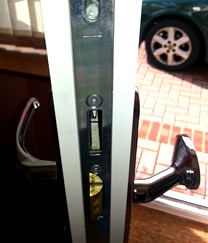
Solid Spindle
Around half of multipoint locked doors have a solid spindle operation on the outside handle. This means that the outside handle does operate the latching bolt and therefore when the door is closed and the hook bolts have not been engaged and locked off with the key someone can walk up to the door, push the handle down and open the door. If you walk out of this sort of door and simply pull it closed behind you will not need the key to get back in. Doors with solid spindles are often found in blocks of flats so that those in the flat don’t accidentally lock themselves out, which is a particular problem if you live above the ground floor.
Kitemarked lock cylinders
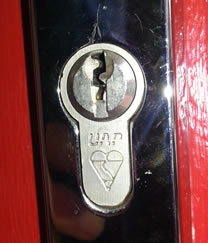
It is also important to point out that my door’s lock cylinder is Kitemarked. This means it’s been independently certificated as being resistant to several forms of attack, including lock bumping. Lock bumping involves the use of a special cut down key, some dexterity and a little tapping of the key. You can read more about cylinder attacks and why you should upgrade your lock cylinders on the website at this link: Replacing lock cylinders – important please read.
In addition to having a secure cylinder the door’s handle assembly has been strengthened to resist attempts to peel it back to get at the cylinder and snap it off.
So, if you’re thinking of replacing your doors then please pay the extra and get doors certificated to PAS 24 2016, which automatically come with these additional security features.
What the burglars do
Burglars simply wander around a neighbourhood during the night trying door handles. If the handle can be pressed all the way down they know that they can easily get in. If the door has a solid spindle operation then they simply need to open the door. If it has a split spindle operation they only need to insert a thin bladed tool between the door and frame to knock back the live bolt (or latch - the brass thing mentioned above) or they can poke something through the letter plate (if you have one) and knock down the internal handle, which will open the live latch.
The correct locking procedure
So let’s go through the process of locking that multipoint locking door:
Lift the handle, turn and remove the key
| Step 1 Close the door! | Step 2 Lift the handle |
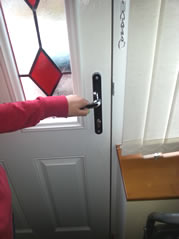 |
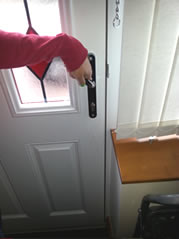 |
| Step 3 Turn the key | Step 4 Remove the key |
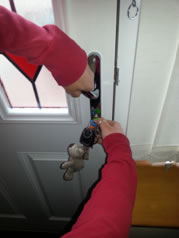 |
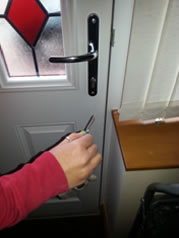 |
| Step 5 Walk away | Step 6 Put key out of sight* |
 |
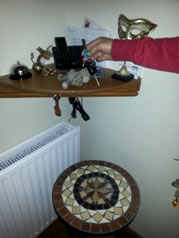 |
*Always leave the key in the same place, so that family members and guests know where to find it in an emergency. If the door has a letterplate you should leave it out of sight from the door so that it cannot be fished for through the letterplate. They may not use the keys to burgle your home, but they may steal your vehicle instead!
Why turning the key is important
When the door is closed and you lift up the handle the hook bolts are thrown into their keeps in the doorframe. You can see the hooks sticking out of the side of my door in the picture below.
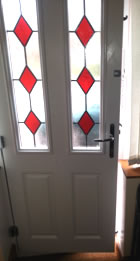
By turning the key in the cylinder, whether from the inside or the outside, you are locking those hook bolts into the positions you can see above. If you don’t key lock the bolts in place they can be disengaged by simply pressing down the outside or inside handles.
Finally
Once the door has been properly locked – especially if it’s a PAS 24 type, it will take an enormous amount of time, effort and damage to overcome it. This is evidenced by the fact that police services have had to develop special methods and equipment to force PAS 24 doorsets and they still often fail to get in. Instead they’ll go through windows or use other methods to affect an entry.
If you live in a block of flats your lock may have a thumbturn on the inside of the door in place of a keyhole. This is because you may need to use this door to get out in an emergency and this prevents you from locking yourself in. Do make sure that a person on the outside of the door can’t access the thumbturn through a letterplate. If they can there are things you can do to prevent it and you should follow this link to find out what to do Letter plates (letter boxes) and mail delivery.
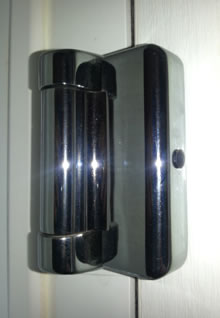
It's also worth pointing out that the hinges on a PAS 24 doorset are substantial as well. This picture just shows one of the three on my door. They are a vital security component of a doorset and work in conjunction with the hook bolts to keep the intruders out.
I hope this information helps you to use the door in the way it was intended to be used!
Updated July 2017, January 2018



